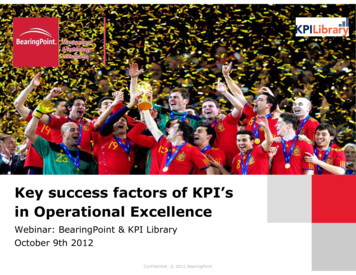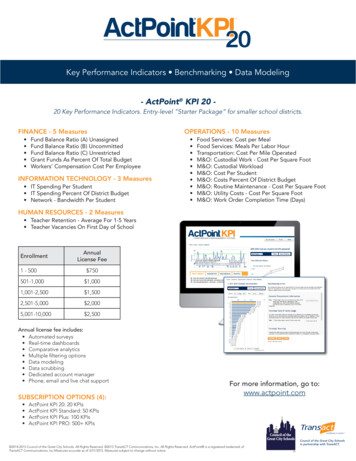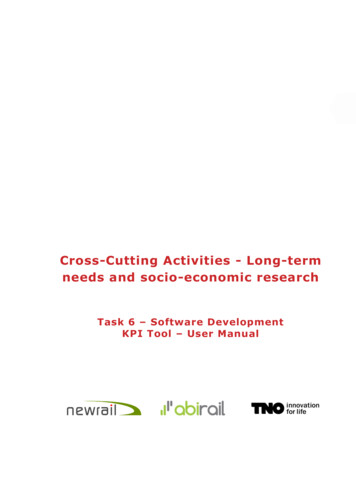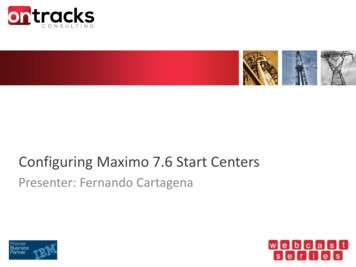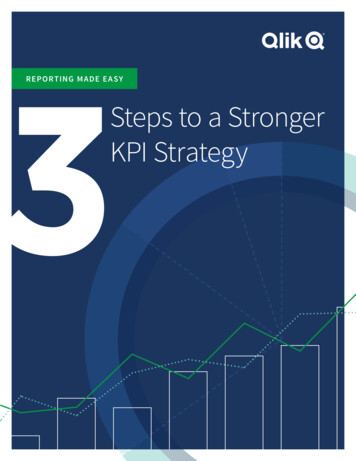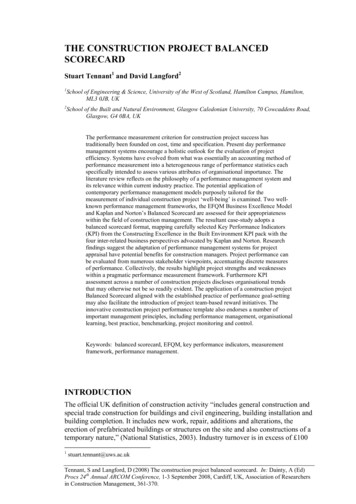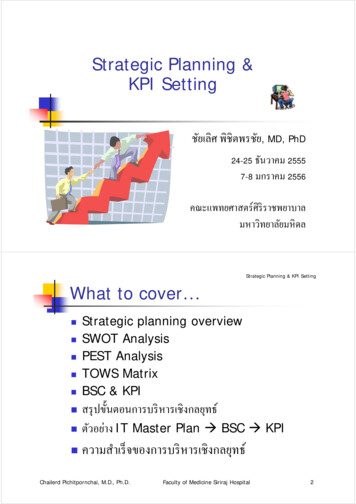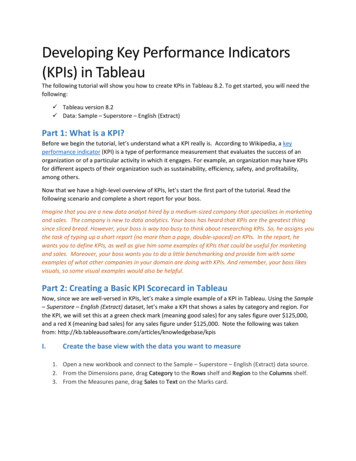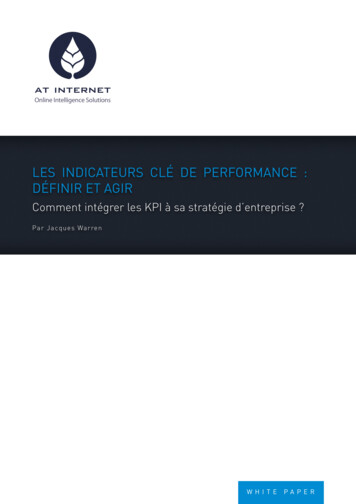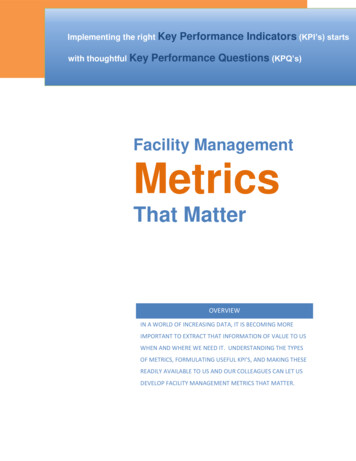
Transcription
THINK ORACLEORACLE BI. THINKTHINK KPI.THINKTHINK ORACLE BI.BI. THINK KPI.KPI.KPI PARTNERS IS AN INDUSTRY LEADER IN PROJECT ANALYTICSKPI Partners is a world class consulting firm focused on Business Intelligence solutions and strategies.KPI Partners’ consultants have experience in managing both IT and non-IT projects (i.e. construction,product development and others) across a multitude of industries. This white paper is written based on thecollective experience of KPI Partners’ consultants in Project Management and in the implementation ofBusiness Intelligence solutions.KPI Partners is an industry leader in Project AnalyticsMany of us at KPI Partners have been involved with Project Management invarious industries – including manufacturing, service and construction. Inaddition, KPI Partners is itself a project-based business and experiences firsthand many of the same challenges described in this white paper.In our experience, the definition of what constitutes a project varies widelybetween departments, industries and even among project managers.A project is often defined as a finite endeavor, having specific start andcompletion dates, undertaken to create a unique product or service which addvalue in terms of additional revenue or reduced cost. All projects haveconstraints like dates, budgets, resources, etc. All projects also have goals andobjectives.Project AnalyticsA Project Analyticssystem helps tomanage projects byproviding keyinformation to all keyproject stakeholders,at the right time, tomake proactive andinformed projectdecisions.Do you know how many projects are underway at your company? Currenteconomic conditions require resources from different teams to bondtogether for mission-critical activities. These are projects! Isn’t trackingperformance a huge priority?The primary goal of a Project Analytics system is to help project stakeholdersmeet project objectives in an optimized manner while honoring the projectconstraints.Project Analytics systems help to manage projects by providing key informationabout the project to the different key stakeholders including: The project team membersThe beneficiary of the project (i.e., employees or customers)The project sponsors or steering committeeThe project funding source (i.e., internal or external)The project cost manager (could be internal finance department orcustomer’s finance dept)The project revenue manager for customer funded projectsKPI PARTNERS PROPRIETARYTel: (510)848-9480 Web: www.kpipartners.com Email: info@kpipartners.com
THINK ORACLE BI. THINK KPI.All stakeholders will have different informational needs that a Project Analytics system needs to satisfy.One primary determinant of stakeholder need is the type of project being analyzed. In KPI Partners’experience with hundreds of projects across multiple industries, we have identified four main projecttypes. These project types and the industries that they are commonly associated with are described inthe next section.Project TypesProject types can be analyzed into four types via a simple 2 x 2 matrix based on the ultimate customer fora project (i.e. internal employees or external customers) and on the funding source for the project (i.e.internal such as a business unit funding an IT project or external such a customer funded project to build anew aircraft).Table 1: Project TypesExternalCustomerType II ProjectType IV ProjectUtility company builds a portal so thatcustomers can pay their bills onlineDefense contractor builds nextgeneration aircraft for the governmentInternalCustomerType I ProjectType III ProjectBusiness funded IT project to improvethe HRMS systemGovernment grant to cross trainemployees in new skillsInternal FundingExternal FundingSeparating projects into types highlights the fact that different types of projects that fall into each of thequadrants will have different analytical requirements that will be outlined further in this paper. Let’s look atwhich industries commonly have which different types of projects.Table 2: Project Types by IndustryType II ProjectExternalCustomerAll industries but common inTelecommunications, Utilities, Businessto Business, RetailingInternalCustomerType I ProjectType IV ProjectAerospace and Defense, ProfessionalServices, Construction, Public SectorType III ProjectAll IndustriesOften seen in Public Sector fundedprojectsInternal FundingExternal Fundinghttp://www.tdwi.org/display.aspx?id 9283KPI PARTNERS PROPRIETARYTel: (510)848-9480 Web: www.kpipartners.com Email: info@kpipartners.comPage 2
THINK ORACLE BI. THINK KPI.Type 1 projects are particularly noteworthy in that they are what are called “Capital Expenditure” projects.In these cases, your company is spending cash (earnings) today to invest in an expected gain that willoccur in the future. For projects of this type, justifications and proposed return on investment (ROI) aretypically established up front. If the project is not carefully managed, the expected pay off is in jeopardy!History shows that projects that are carefully managed – large or small – are considered most successfulboth in the short and the long term. Project Analytics systems help manage projects in almost all cases.Individual requirements will determine specific metric needs, but all projects have a customer and arefunded by someone. It is recommended to use the tables above as a guideline to position your projects,and then manage them using software specifically designed for this purpose, such as Oracle’s newlyreleased Project Analytics application.Project ProgressA good Project Analytics system will need to meet the needs of all four project types. Of course, one canbe guaranteed that during the course of any project, the analytic system will need to answer theubiquitous question: How is the project going?The question may be asked by a resource working on the project or by a senior executive who is theexecutive sponsor responsible for the project. The answer will vary depending on the project type and theproject stakeholder asking the question.An all too typical answer to this question for a Type 1 project might be:"Well, we are just under budget but we have another eight weeks to go which is a three weeks more thanwe planned but that is OK because there were two change requests early on that increased the scope. Ithas taken more hours than we expected to complete the current phase, but we worked over theChristmas break, which was expensive, but we used lower level cheaper resources so it didn't cause toomuch problem. Given everything, I think we will probably be all right."Sound familiar?For a Type III or Type IV project (i.e. external customers and external funding), the following mightbe added to the response above:“I am not sure if we are making money on the project because the costs have really gone up. In addition, Ihave no visibility as to whether the client has actually paid for the milestone invoices we sent a monthback. This means we may have more financial exposure if the next phase of the project has any hiccups.”What does this mean? It sounds like an elaborate smoke screen and it quite possibly is. On the otherhand, it is more likely that the Project Manager does not have the information he needs to answer thequestions asked of him because it doesn’t exist, or because is scattered in multiple systems. Some of theinformation might be in his project management system, some of the financial information might be in theERP systems, and some of the project quality information may be in a defect tracking or casemanagement system. Other information is not captured at all.KPI PARTNERS PROPRIETARYTel: (510)848-9480 Web: www.kpipartners.com Email: info@kpipartners.comPage 3
THINK ORACLE BI. THINK KPI.Project Analytics FrameworkThere is a better way for the Project Manager to be able to answer these questions for himself and to hisstakeholders. It is by first constructing a clear framework for project performance and management. Theframework will vary based on the project type but will have many common elements as shown in thetable below.Table 3: Project Analytics Framework#Success enue7 Financial Performance(Margin, Cash Flow)Project Type I & IIProject Types III and IV(Internal/External Customer,Internal Funding)(External Customer, ExternalFunding) PossiblePossible The success criteria that project stakeholders focus on will vary somewhat by stakeholder and projecttypes but will generally contain the seven items listed in the project framework. A notable exception isthat revenue may not be tracked on internally funded projects. In addition, the financial performancemetrics for a non-revenue generating project will focus primarily on variance reporting between budgetcosts and actual costs. In revenue generating projects, there are a host of additional financialperformance metrics such as profitability and cash flow.As part of the preparation process for the onset of any project, it must be determined which metrics aremost important to ensure the success of the project. Also, the Project Type (based on the 2x2 tables onpage 2) should be determined so that all stakeholders agree on the customer and funding of the project.Some projects may be a combination of types, but it is important to communicate all project informationwithin the company prior to the project start.The next sections will describe in detail some of the key metrics, dimensions, data sources andcapabilities for the seven elements of a project analytics framework as described above.KPI PARTNERS PROPRIETARYTel: (510)848-9480 Web: www.kpipartners.com Email: info@kpipartners.comPage 4
THINK ORACLE BI. THINK KPI.Schedule MetricsSchedule metrics answer the basic project question of whether or not the project is on schedule. Thisquestion is typically answered with the following key metrics: Number of overdue tasksNumber of tasks starting later/earlier than planned% Completion vs. Expected % CompletionVariance between Expected Completion Date vs. Actual Completion DateAt any point in a large project, there will probably be some tasks behind schedule and an equal numberahead of schedule.Project stakeholders want to understand these metrics along the following key criteria or dimensions:project, resource, location, task type and organization.Scope MetricsScope metrics answer the basic project question of what tasks need to be done in order to complete theproject. A common question that is frequently asked is about “scope creep”, which is the addition of moretasks being added to a project without adding appropriate resources or time or funding to the project.Some examples of key scope metrics are: Number of tasksUnits of output (i.e. number of widgets, etc.)Increase or decrease in number of tasks or units of output as compared to a project baselineNumber and cost of change requestsEvery project will have some scope changes. A weakness in most project management activity is thatscope changes are not monitored and approval is often verbal and not recorded. A better way to managescope change is to account for it in the planning stage - there will be scope changes, and they must beallowed for. The next step is to put in place a tracking system with appropriate approvals. Scope metricsdepend on a scope tracking and management system to capture scope information throughout theduration of the project.Project stakeholders want to understand these metrics along the following key criteria or dimensions:project, resource, location, task type and organization.KPI PARTNERS PROPRIETARYTel: (510)848-9480 Web: www.kpipartners.com Email: info@kpipartners.comPage 5
THINK ORACLE BI. THINK KPI.Resource MetricsResource metrics answer the basic project question of what resources are allotted to a specific projectand whether these resources are under-allocated or over-allocated. Resources can be people orequipment, etc. Some examples of key resource metrics are: Number of resourcesResource utilizationResource hoursAmount of resource overtimeVariance Analysis in terms of Budgeted Resource vs. Actual Resources consumedIn addition to project resource usage, it is important to have a project resource budget at the start of theproject so that resource variance can be tracked.Project stakeholders want to understand resource metrics along the following key criteria or dimensions:project, resource, location, task type and organization.Quality MetricsQuality metrics answer the basic project question on the quality level of the project deliverables. This isoften one of the most challenging metrics to capture. However, with the widespread usage of issuemanagement, defect tracking, warranty management and other systems, this information is more widelyavailable than ever. Some examples of key quality metrics are: Number of high/medium/low defectsNumber of open/closed/deferred defectsCost to fix defectWarranty costsStatus of quality tasksNumber of Quality Assurance plan tasks completed and outstandingOne way to monitor quality is to set up a quality assurance project plan with quality events marked at theplanning stage. These are activities that can be undertaken to check quality and could include activitiessuch as walkthroughs, document inspections, or testing of a particular component. As each of theseevents is completed, these tasks can be reported on.Project stakeholders want to understand quality metrics along the following key criteria or dimensions:project, resource, location, task type and organization.KPI PARTNERS PROPRIETARYTel: (510)848-9480 Web: www.kpipartners.com Email: info@kpipartners.comPage 6
THINK ORACLE BI. THINK KPI.Cost MetricsCost metrics answer the basic project questions on project cost. Some examples of key cost metrics are: Types of cost such as people, equipment, etc.Billable vs. non-billable costsTravel costsAllocated costs (i.e. burden)Variance analysis (budget vs. actual)It is important to have a cost budget by time period so that actual costs can be compared to budget for aparticular period of time. It is not sensible to monitor budget in total. For example, if the budget wereexpended half-way through a project, this would not provide any warning that the problem occurred andcould cause serious jeopardy for project completion. For this reason, a project cash flow needs to becreated for the budget and monitored at all times. Typically this is would be an estimate month by monthof expenditure.Project stakeholders want to understand cost metrics along the following key criteria or dimensions:project, resource, location, task type and organization.Revenue MetricsRevenue metrics are applicable to external customer facing projects. They answer the key question ofthe financial resources available to cover the costs of a project. Revenue could be in the form ofcustomer invoicing, or of grants from a funding body. In addition in order to be billed and invoiced asrevenue, organizations that manage projects, like construction companies and professional servicescompanies, also need to account for the bookings and backlogs so that future projects can be efficientlyplanned for.Some examples of key revenue metrics are: Total revenueBilled revenueUnbilled revenueTotal fundingFunding availableProject stakeholders want to understand revenue metrics along the following key criteria or dimensions:project, resource, location, task type and organization.KPI PARTNERS PROPRIETARYTel: (510)848-9480 Web: www.kpipartners.com Email: info@kpipartners.comPage 7
THINK ORACLE BI. THINK KPI.Financial Performance Management MetricsThe last metric types in the Project Analytics framework are financial performance management metrics.Financial performance management metrics are applicable to externally funded projects (i.e. Type III orType IV). They answer the key question of how the project is performing on a financial basis. Someexamples of key financial performance management metrics are: Budget vs. forecast vs. actual for revenuesBudget vs. forecast vs. actual for revenuesProject profitabilityProject cash flowTime-based trending metrics – Quarter over quarter increase, year ago, month ago, etc.Project stakeholders want to understand financial performance metrics along the following key criteria ordimensions: project, resource, location and organization.Project Reporting Strategy: Top Down or Bottom UpNow that we have established the type of project and the types of metrics that are required for acomplete Project Analytics framework, it is useful to consider the two different approaches to projectreporting: Top Down and Bottom Up.Top Down ApproachThe top down approach looks at the overall objectives of the project and breaks them down into metricsthat can be measured. In this case, understanding how executive management will measure the successof the project is critical. Will the success be measured by an -time completion date, finishing within orunder budget, usage of eco-friendly products, building of reusable plant components or other measuresthat are critical at the executive management level?Once the top-level objectives are understood, supporting metrics can be drawn from the project. Theproject plan and the actual and budget and financial statements are the first places to look. In support ofthe objectives, metrics from these systems can be gathered. For example, if the key measurement is ontime delivery, measurement of the planned interim milestones versus actual dates is an obvious place tostart. It is important that each objective should have at least one metric to measure projectsuccess/failure rates.KPI PARTNERS PROPRIETARYTel: (510)848-9480 Web: www.kpipartners.com Email: info@kpipartners.comPage 8
THINK ORACLE BI. THINK KPI.Bottom Up ApproachThe bottom up approach looks at the project from the project manager's level first. He or she will needkey metrics to provide insight into the health of the project. Although many metrics will be the same aswith top down, there will also be a host of new metrics which are key to the project manager.Examples of these metrics include staffing levels – are the staff under- or over allocated? And, materialconsumption metrics – are waste expectations being met? The strength of the bottom up approach is thatthe details will provide the baseline for a roll up to executive appropriate metrics.Both Approaches are required for Successful ProjectsWith KPI Partners’ experience delivering a multitude of projects across multiple industries, we have seenthat both the bottom up and top down approaches are required in the right balance to meet the objectivesof the specific project. In fact, a Project Analytics solution needs to be able to support both top down andbottom up reporting and analysis.Criteria for a World Class Project Analytics SolutionHaving now established a framework for project analytics across project types, it is useful to specify boththe functional and technical criteria for a world class Project Analytics solution.Firstly, a world class project analytics solution needs to be designed to meet the needs of: the four main project typesthe needs of multiple industriesdifferent project management methodologiesTo accomplish this, a world class Project Analytics solution needs to have the following features: Aggregate information up and down common hierarchies such as time, organization, geography,etc. to facilitate both a top down and a bottom up approachInformation can be sliced and diced on key criteria such as time, organization, cost center, etc.Contain the key metrics required to satisfy the project analytics frameworkBe an open system that allows information from multiple systems to be integrated into the ProjectAnalytics solutionMeets the needs of customers in multiple countri eivables, UnearnedRevenue, Invoiced Amount, # of Approved Invoices, Retention Billed,Retention Withheld, Write-off AmountMargin, Margin Percent, Forecast Margin, Margin Change, Cost Variance,Forecast Cost Variance, ETC Burdened Cost, ETC RevenueData Integration Options for Oracle Project AnalyticsIt is important to understand that project information exists in a wide variety of both structured andunstructured data sources.Unstructured data is typically contained in emails, Word documents, etc. Structured data sources whichcan be more easily integrated and reported on include: Project management software as such as Oracle Primavera, Microsoft Project, etc. which containproject schedules, resources, tasksERP systems such as Oracle eBusiness Suite and Peoplesoft which contain project costing,revenue, invoicing, funding, time sheets, expenses, etc.Excel spreadsheetsProject quality systems such as Siebel Service, Mercury Quality center, etc. where defect andquality issues are tracked and managedThe ideal solution is to integrate these disparate sources into a central data source. However, this is notalways possible. Oracle Project Analytics provides a fully open architecture that provides customers witha wide variety of choices to access project data. Table 5 lists the wide variety of reporting and dataintegration options available with Oracle Project TARYTel:(510)848-9480Web:www.kpipartners.comTel: (510)848-9480 Web: www.kpipartners.com omPagePage1112
THINK ORACLE BI. THINK KPI.Table 5: Reporting and Integration Options for Oracle Project Analytics#Metric TypeTypical Data Source1ScheduleProject managementsystems such asOracle Primavera,MS Project etc.Excel, CSV nueFinancialPerformance(Margin,Cash Flow)Project managementsystems such asOracle Primavera,MS Project etc.Excel, CSV files,databasesProject managementsystems such asOracle Primavera,MS Project etc.Excel, CSV files,databasesDefect tracking andissue mgmt systemssuch as SiebelService, MercuryQuality CenterERP systems suchas Oracle EBS andPeoplesoftERP systems suchas Oracle EBS andPeoplesoftERP systems suchas Oracle EBS andPeoplesoftReporton datadirectlyusingOBIEEExportdata toCSV,Excel etc.andreportusingOBIEE N/A N/A N/AExport data toCSV, Excel etc.and bring intoOracleAnalyticsWarehouseAvailable Outof the Boxfor OracleEBS andPeoplesoft KPI PARTNERS PROPRIETARYTel: (510)848-9480 Web: www.kpipartners.com Email: info@kpipartners.com Page 13
THINK ORACLE BI. THINK KPI.Deployment Options for Oracle Project AnalyticsFinally, it is important to consider how a Project Analytics solution should be deployed to projectstakeholders in order to maximize user adoption and functionality and minimize the total cost ofownership. Since Oracle Project Analytics is a very open technology, it can be easily integrated intoexisting systems. There are a number of deployment options: Stand Alone Deployment in a separate project analytics applicationWithin Existing Project Portal such as Oracle Portal, Sharepoint, etc.Within an ERP System. Integrate to existing ERP systems where time and expense information isstored. Out of the box integration to Oracle eBusiness Suite and Peoplesoft is available.In addition to deployment options, security is also an important consideration to ensure that users canaccess the Project Analytic system in an easy but secure manner, and also see only the information theyare authorized to see. Oracle Project Analytics has extensive security capabilities to addressauthentication, authorization and data security needs: Authentication (i.e. log on to the system)––– Authorization (Decide which reports and dashboards can be seen by role)––– Separate authentication for Project AnalyticsAuthentication via enterprise authentication mechanisms such as Oracle Internet Directory,LDAP, Microsoft Active DirectorySingle Sign On with project application or ERP systemProject executiveProject managerProject resourceData Security (What project data should be seen by role)––Which projects to be seen by role or userWhich metrics and data to be seen by role or userConclusionThere is a saying that if it cannot be measured, it cannot be managed. Traditionally, projects have usedschedules and budgets to monitor progress. This only provides part of the answer. It does not addressother variables. Just because a project comes in on time and on budget does not mean it is a success.The deliverables may be of poor quality, and there may be dozens of outstanding issues. A much broaderview is required to insure a project’s ultimate success. The Project Analytics framework presented in thiswhite paper details the elements of a complete project analytics framework and how Oracle ProjectAnalytics meets the needs of this framework.Doc PA V1 0513KPI PARTNERS PROPRIETARYTel: (510)848-9480 Web: www.kpipartners.com Email: info@kpipartners.comPage 14
KPI Partners' consultants have experience in managing both IT and non-IT projects (i.e. construction, product development and others) across a multitude of industries. This white paper is written based on the collective experience of KPI Partners' consultants in Project Management and in the implementation of Business Intelligence solutions.
